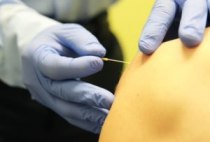Dry Needling Therapy
Effective for muscle "knots" and nerve pain

Dry Needling Shoulder Pain
We offer Dry Needling Therapy to patients in Olathe, Overland Park, Lenexa, Gardner, Johnson County, and the Kansas City Area.
Our clinic was amongst the first to be certified in dry needling and have many patients that achieved excellent clinical outcomes with the help of this modality. In 2019 we became the first practitioner in Kansas City to be fully certified in Integrative Dry Needling (CIDN).
Dry needling is a treatment where small, solid needles are placed in dysfunctional tissues, and thus is a therapeutic modality for soft tissue dysfunction. This intervention effectively treats tissue inflammation, sensitized nerve tissue, scar tissue formation/adhesion, and deficiency of blood/lymph circulation. It’s beneficial due to local effects, such as reducing tissue tension, normalizing inflammation, and promoting local soft tissue remodeling. It also has systemic and regional benefits including remapping of central pain matrices, release of endogenous opioids, increased muscle oxygenation, and alterations of proprioception/afferentation. (7, 8, 9, 10)
Neurogenic Inflammation related to Dry Needling - Key to understanding the benefits of dry needling is the concept of neurogenic inflammation, which is characterized by sensitized nerve endings, tissue edema, and infiltration by immune cells. Under pathologic conditions sensitizing neuropeptides can be released from sensory nerve endings and influence basic tissue functions and propagate the aforementioned dysfunctional tissue state. Thus, a nerve itself can be the perpetuator of soft tissue dysfunction/pain (11). Alarmingly, these conditions can rapidly diffuse to neighboring tissues and promote systemic dysfunction (1, 2, 3, 4).
We use Dry Needling to treat neurogenic inflammation as part of a treatment paradigm that continues to address muscle contracture, joint hypomobility, and muscle inhibition with other treatments.
Examples of treatment:

Headache - One spectrum of disorders that has responded particularly well to the revised dry needling protocols are headaches. Here is an example of needling for lateral facial/temporal distribution of sx. This pattern addresses a sensitized auriculotemporal nerve, as well as branches of the trigeminal nerve. Most patients report immediate, lasting improvements.
Peripheral Nerve Entrapment example: in the past we have utilized nerve glides along with myofascial release to help many patients with nerve entrapments. Using revised protocols for dry needling, we are creating faster improvements and helping even very stubborn cases. Pictured is an ulnar nerve entrapment example. The locations of needle placement and sensitized tissues along the path of the nerve are the tunnel of Guyon, aponeurosis of the flexor carpi ulnaris, cubital tunnel, and arcade of Struthers. Note that microcurrent is being utilized in this example. The combination of dry needling with electrical stimulation has been found to produce a stronger analgesic effect and it maximizes the effects of treatment (5,6).
Tempromandibular Dysfunction (TMJ) can be particularly stubborn and painful. Here is an example of needling directly into the lateral pterygoid, which attaches directly to the TMJ capsule and intra-articular
disc. This particular procedure is moderately uncomfortable, but the duration of post treatment soreness tends to be fairly brief.
Utilizing the combination of treatments we have successfully employed in the past in addition to revised, less painful, more effective dry needling protocols, the results are speaking for themselves. Since opening our doors in 2008, we are getting the very best clinical outcomes we’ve ever achieved.
Please feel free to contact our office about any questions regarding our clinic’s diagnostic or treatment protocols.
References:
1) McBeth J, Simmons D, Silman A, et al. Musculoskeletal pain is associated with a a long-term increase risk of cancer and cardiovascular-related mortality. Rhuematology 2009;48:17-11
2) Backryd E, Tanum L, Lind A, Larsson A, Gordh T. Evidence of both systemic inflammation and neuroinflammation in fibromyalgia patients, as assessed by a multiplex protein panel applied to the cerebrospinal fluid and to plasma. Journal of Pain Research2017;10:515-25
3) Liu L, Liu B, Chen S, et al. Visceral and somatic hypersensitivity, autonomic cardiovascular dysfunction and low grade inflammation in a subset of irritable bowel syndrome patients. Biomed & Biotechnol 2014;15(10):907-14
4) Shah J, Danoff J, Desai M, et al. Biochemicals associated with pain and inflammation are elevated in sites near to and remote from active myofascial trigger points. Arch Phys Med Rehabil 2008;89(January):16-23
5) Schliessbach J, van der Kilt E, Arendt-Nielson L, Curatolo M, Streitberger K. The effect of Brief Electrical and manual acupuncture stimulation on Mechanical Experimental pain. Pain Medicine 2011;12:268-75
6) Manheimer E, Cheng K, Linde K, et al. Acupuncture for peripheral joint osteoarthritis. The Cochrane database of systematic reviews. 2010(1):CD001977
7) Huang W, Pach D, Napadow V, et al. PLoS One. 2012;7(4): e32960
8) Napadow V, Makris N, Liu J, Kettner NW, Kwong KK, Hui KK. Hum Bain Map. 2005;24(3):193-205
9) SZyloney C, Jensen K, Polich G, et al. Imaging the functional connectivity of the periaqueductal Gray during genuine and sham electroacupuncture treatment. Molecular Pain 2010;6(80)
10) Kimura K, Ryujin G, Uno M, Wkayama I. The effect of electro acupuncture with Different Frequencies on Muscle Oxygen in Humans. Evidence-Based Complementary and Alternative Medicine;2015 (http://dz.doi.org/10.1155/2015/620785).
11) Greening J, Anantharaman K, Young R, Dilley A. Evidence for Increased Magnetic Resonance Imaging Signal Intensity an Morphological Changes in the Brachial Plexus and Median Nerves of Patients with Chronic Arm and Neck Pain Following Whiplash Injury. JOSPT 2018;48(7):523-32
